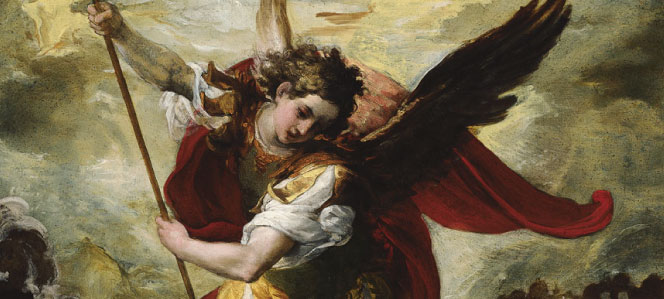“Saint Michael the Archangel, defend us in battle, be our protection against the wickedness and snares of the devil. May God rebuke him we humbly pray; and do thou, O Prince of the Heavenly host, by the power of God, cast into hell Satan and all evil spirits who wander through the world seeking the ruin of souls.”
This prayer, a staple of devotion for the Church faithful during the late 19th and early 20th centuries, was composed Pope Leo XIII in 1886. Tradition holds that Pope Leo XIII was granted an explicit vision of Satan and his minions, a vision that laid bare the depth of evil in its purest form. After this horrifying apparition, the Pope immediately retired to his quarters and composed a longer version of the prayer cited above, a spirited plea for the intercession of the archangel whose very name rebukes Satan’s grasp at divinity, “Who is like God?” St. Michael the Archangel.
Today is the Feast of St. Michael and two of his archangel companions, Gabriel and Raphael. The scriptural appearances of these purely spiritual beings are characterized by the earth-shattering descent from another mysterious realm that effects a responding ascent from ours. The exercise of their status as messengers from the Divine mark pivotal turning points in salvation history, especially on display in the interplay between Gabriel and Mary that led to her beautiful fiat. Mary’s saving “yes,” prompted by Gabriel’s annunciation, allowed the Divine Word to become flesh in the great event of the Incarnation. Divinity and humanity collided, and this mysterious messenger known as Gabriel was the bridge between these two worlds.
Our recognition of the archangels as spirits who periodically break into our reality, who form the “stratia” of God– a spiritual army whose heavenly power is exercised in an indescribable realm far beyond our own, implies the reality of their opponent. The prayer inspired by an other-worldly vision and uttered first by Pope Leo XIII takes seriously the ironic power of vacuity—the life-sucking, empty, and gruesome dimension of the obstinate denial to participate in goodness. Satan, our tradition holds, is the embodiment of this ruinous choice. However, the infectious, luring power of Satan’s choice lies in its ability to masquerade as something good; his conversion technique is successful to the degree to which it remains hidden and offers a false “desirable.”
C.S. Lewis often alludes to the idea that if we ever truly saw evil —in its unabashed ugliness— we would be so completely reviled and repulsed that we would never choose it. Instead, however, the master of deceit convinces us, as he convinced Eve in that primeval garden, that his choice is the better, more desirable, even more beautiful one. He sneakily rides on God’s coattails, and our lukewarm desire to have our apple and eat it, too, allows the ugliness of evil to remain in costume… a harmless, anthropomorphic snake, a “red man with a pitchfork and goatlike horns,” a creeping, relativistic morality that allows the individual to reign supreme with his/her claim to the ultimate “knowledge of good and evil.”
Not so for Pope Leo XIII. Not so for St. Michael the Archangel and the heavenly host. They saw. They encountered. For them, the true face of evil was known and this awful face served as a catalyst for heroic mission.
On this Feast of the Archangels, how are we—the unconsciously deceived— to join the battle? If seeing evil is key to fighting it, how are we to train our eyes and form our vision?
Here is an idea: recently, in a review of the CATHOLICISM series, a commenter made the casual assessment that Bishop Barron, in the way he identifies both elements of goodness and well-intentioned deviations from truth on display in the broken vessels of humanity, “just won’t give the devil a foothold.” He claims for God the goodness that properly belongs to his nature. He takes from the devil’s clutches all of his ammunition, transforms that which evil intends to use for its own purposes (for further deceit, for greater despair) and sanctifies it for God by identifying its goodness or deviation thereof. In the form of the great evangelization, he seeks to uncover and uphold the truth and align it with Truth, itself.
This offhand commentary pinpointed what it is that we have… and how we can fight. We cannot always see the stark wickedness of Satan, but we can, if we commit to constantly transforming and re-aligning our vision through prayer, be drawn into the vision of the enticing goodness of God. Then, encounter by encounter, person by person, opportunity by glorious opportunity, we can re-claim creation for God and creatively snatch this foothold from Satan.
And, we have a whole stratia behind us in the battle.
Sts. Michael, Gabriel, and Raphael, pray for us!
